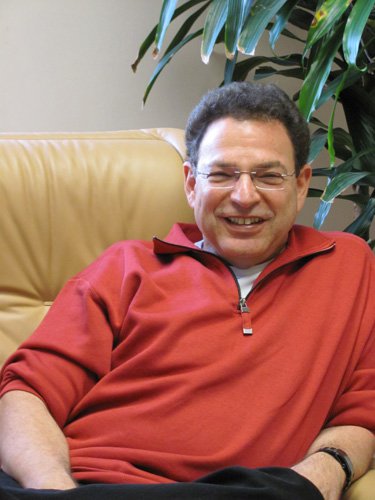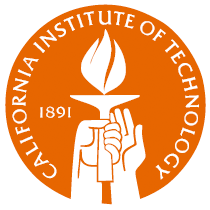How would Jehoshua "Shuki" Bruck sum up his success as a teacher in just three words? "I love ignorance," declares the exuberant winner of Caltech's 2008 Feynman Prize for Excellence in Teaching.
Shuki, as everyone calls him, is Caltech's Gordon and Betty Moore Professor of Computation and Neural Systems and Electrical Engineering. The Feynman Prize citation praised him for his "development of a new course, IST [Information Science and Technology] 4, 'Information and Logic,' as well as other teaching activities, including informal mentoring of undergraduates." An avalanche of recommendations commented on the breadth, humor, warmth, openness, and originality he brings to his teaching and on the special quality of his relationship with students. No one mentioned ignorance.
Shuki first taught IST4 in 2007, and he credits Caltech's interdisciplinary environment with sparking his interest in the subject not long after he arrived on campus in 1994. He played a leading role in conceiving and establishing Caltech's IST program, which culminated this October in the opening of the new Walter and Leonore Annenberg Center for Information Science and Technology. Heidi Aspaturian of Caltech's communications office recently sat down with Shuki to get a firsthand idea of what it takes to be deemed a great teacher at Caltech.
Many people who nominated you for the Feynman Prize described IST4 as one of the best courses, if not the best, that they had taken at Caltech. What can you tell us about it?
SB: I first started thinking about this topic many years ago. Caltech turns out to be the perfect environment for thinking broadly about information science because we have so few disciplinary boundaries. Since I first came here, I have been very lucky to interact with people across all our divisions, from biology to physics to the humanities. And that helped me to realize that the topic of information systems encompasses far more than just computers. The cell, the brain, the Internet, and national and global economies are all information systems. What they all have in common is that information flows in and some manifestation of it flows out.
At the same time I realized that the biggest challenge in trying to understand all these different systems is that we don't have a good language—good mathematical tools, if you will—for dealing with them. We are collecting huge amounts of information, and we not only don't know what to do with all of it, we are also missing a good unifying framework for thinking about it. And yet that hasn't stopped us from being able to design, build, program, and use complex systems like tiny computer chips with one billion components to solve extremely difficult computations. How are we able to do it?
That question led me to a much larger one, namely, how did we get here from there? How did we, as humans, get from having no conscious concept of numbers to a point where we are suddenly awash in all this advanced computational technology? What were the key milestones in this evolution? Classes about information science don't really deal with these questions. They focus on what's happened over the last 50 years or so, when that is really only a small part of a much bigger picture.
So I started reading and the more I read, the more questions I had. And you know, one of the best ways for a professor to learn more about a topic is to teach it. That's when I designed and started teaching this course. Three years later, I have to say, I still feel ignorant about the subject. But I love ignorance. It's something I truly love about my job—how to enjoy ignorance, and how to turn that feeling of ignorance into high energy and curiosity that I can then share and pass on to my students.
How do you go about relishing ignorance in this particular class?
SB: I begin with what you might call the puzzle of our innate sense for quantities. How is it, for example, that when we look at two piles of apples, we somehow know that one pile contains more fruit than the other? Without knowing about the actual numbers themselves, we can still make this determination. There is a whole research area in cognitive science regarding number sense and the discovery that many animals—rats, crows, dogs, and so forth—have at least a rudimentary quantitative understanding. We now know that babies, long before they can talk, are able to relate to quantities and are pretty good at adding small numbers. So the first problem sets relate to these questions.

From there we look at early civilizations, starting with the Babylonians, who were amazingly sophisticated with numbers and numerical calculations. Among many other things, they invented base 60, which still serves as the basis for how we tell time. In computation, they had a wonderful representation that is actually a combination of base 60 and the binary system.
So we start with anthropology and ancient cultures, and even as we move into the Age of Enlightenment and the dawn of computational science in the 17th century, I try to retain this context. Eventually we reach the 20th century and the birth of modern computational approaches and computer technologies.
It is an evolving process, and I am always adding and experimenting with new material. Last year, I introduced material about language, specifically literacy versus illiteracy, and how that affects our thinking and our perceptions. We talked about some very interesting research related to how the ability to read and write shapes the way we perceive the world, and we tried to connect that aspect to the development of mathematics as our language for reasoning about the physical world. When I teach the class in '10, I am planning to bring in the whole notion of how creativity works. We'll talk about some famous innovators who developed ideas that are completely out of the intellectual mainstream and we'll explore how that occurred.
When your students encounter this rather unorthodox blend of hard science, mathematics, and intellectual history, how do they react?
SB: Some students really like it. Some just tolerate it. There are others who say, okay, just show us how we got computers and let us work on computational techniques—who cares about the Babylonians? In some sense this relates to the whole philosophy-of-education question—whether it is more important to teach content or context. As I said earlier, I think we need to teach both. I will sometimes say to my students: This class is useless in the sense that you cannot take it and go get a job in a high-tech company and do something useful. This is not the idea. The idea is to teach you about the context in which ideas evolve, to amplify your curiosity, and to help you understand the dynamics of creativity and problem solving in a global sense over time. That's what I'm trying to convey.
How would you describe your overall philosophy of teaching? Or do you have one?
SB: I'll tell you a story. When my son was in second grade, he asked me about something mathematical, I think involving addition. I was trying to explain to him the idea and afterward, he said, "Dad, when you were explaining this, you were smiling all the time. Why?" And I said, "It's because I like this stuff." And you see, that's a key thing that we need to teach. We are teaching "the smile." We as teachers need to show the students that it's fun to understand the ideas that we present. This is how you amplify interest and curiosity. And you cannot cheat on that, right? If it's not fun, who will want do it?

But I think that the most important thing we do is actually shown on the Caltech logo, where you see the flame, the torch, and the two hands. The two hands aren't holding the torch together; one hand is passing it to the other. And this is something that is key to civilization. It is like DNA, but it is intellectual DNA—passing down the light of knowledge. To do that, it's not enough to teach and learn the mechanics of how to solve a quadratic equation. If you want to deepen understanding, you need to talk about the context in which the ideas you're teaching evolved.
I always try to emphasize that solving a problem or coming up with new ideas is a process, and that as students become accustomed to this approach, they should feel joyful in accomplishing it. When I give them their early homework sets, I will tell them that certain problems will probably not be difficult—they are directly related to what we have studied in class. However, they will also find that other problems are not so straightforward, that they require more thinking. I tell them, "At first, you won't have any idea how to approach it. That's wonderful—that's the feeling you should have. Go and have fun. Go play music, go to the gym, go and see a movie. When you come back, take a look at it again, and the next morning you will have some idea, and you need to let yourself go through that."
Nearly every letter about you to the Feynman Prize Committee commented on the strong personal interest that you take in your students' welfare, both in and beyond the classroom. Do you think this attitude comes naturally to you, or did it develop out of years of teaching?
SB: What I think it comes down to is that I really like people. It's very hard to teach people unless you also have a sense of how they think and feel and where they are emotionally. I believe that classroom teaching is just a small part of our job. In the end what the students remember about the coursework is not the key. The key is that hopefully I am serving as a good model for them with regard to how to behave in a position like this—how to teach and how to relate to other people. And I hope that I can give them an example of what I believe is a good value system. Sometimes my students will tell me, "You helped me so much, and I don't know how I can thank you properly." I tell them it's very simple: just do the same thing when you are in my position.
You spent almost two years, in 2006–2008, living with your family among students as a professor-in-residence at Avery House. What impact did that have on your teaching?
SB: I think it made me a better teacher, particularly of undergraduates. In my first years here, I taught mainly graduate classes, and my interaction with undergraduates was limited. I don't think I was able to "read" what they were saying all that well. Living in Avery, I began to feel that I could understand them much better. I suddenly became much more knowledgeable about the challenges of being an undergrad here.
What would you say are the top three challenges?
SB: The students who come here are gifted in so many ways—it's unbelievable. But for many of them, it's their first time in a community where everyone else is just as talented. It can be disconcerting to discover this, and there are different ways to handle it. One way is to be extremely happy that now you too are ordinary. Personally I feel like an average guy here at Caltech, and it's a great feeling, because this is how I know I am at the right place. For some people, however, it's hard to deal with. My experience with the students here is that the happy ones are those who accept who they are, regardless of where they are academically. Even if you are the best student at Caltech, you still need to learn how to manage that. Don't be arrogant. Do develop a social system that is not based on academic achievements but on interpersonal relationships and emotions. It doesn't matter what your class ranking is. You need to accept it and forget about it, and treat yourself as a whole person.
The second challenge is that when someone is the best student in their school, or their city, or maybe even in their state, then that is "their" movie. You know the saying that everyone lives in some kind of a movie? That's their role—best student in New York. Then they come to Caltech. Now they are just one of the undergrads at Caltech. They are not even the best student in their student house. So suddenly it's a different movie and they need to adjust to their new role. That's a positive challenge, in my opinion.
The third challenge is that when these students are in high school, they are so talented that they can do very well without actually having to go into much depth about the material they are studying. It's not so easy to skate by that way here, and learning how to delve deeply into subjects or ideas doesn't just happen overnight. It's a matter partly of talent and partly of curiosity. And I think the main challenge for us as teachers is to make sure that curiosity flourishes.
If young colleagues just starting out asked you for advice on how to be a successful teacher, what would you tell them?
SB: Let me just say first that I am not sure I am a successful teacher. This award was a huge honor, but an even bigger surprise. Over the years I have started to feel more confident about teaching, but I still have a long way to go.
But I think that the key is really to love the material. It all starts with that and continues with a constant effort to discover new possibilities in the material and new ways to explain it, first to yourself, and then to others. That is how you pass on the light to the next generation. And you have to be willing to take risks. It's never clear when you set out to explain something whether the approach you've chosen is going to work. It might work well in your mind but then not so well in practice. It might work with one audience but fall flat with another. I have to say that I am naturally nervous about my teaching. I might not appear that way, but I put a huge amount of time and thought into preparing for my classes and I am always very anxious before a class. I have some story line that's all over the place in my brain and I'm trying to get it out in a lucid way. You have to be willing to experiment, to listen to feedback from your students, and to accept the fact that not everything you try is going to succeed.
What's most important, I think, is to reach into whatever your passion is and try to express it, explain it, and if it doesn't work well the first time, then try again.
And, again, I think the connection with the students is really why we do this job. Even if all that my students learn is how I treat them in class and how I respond to questions, that's a valuable lesson about information. It may be the most valuable one I can teach.
So that would be my suggestion to young people who aspire to teach: try to connect with your students because, in the end, whatever they get from you, you will get so much more from them. And I should also mention something that strikes me each year as I look at a new class for the first time: your students help keep you young. We get a bit older every year, but our undergraduates—they stay forever the same age.
Written by Heidi Aspaturian









